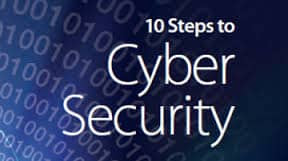10 steps to cyber security:
Guidance on how organisations can protect themselves in cyberspace, including the 10 steps to cyber security
Executive Summary:
Guidance on how organisations can protect themselves in cyberspace, including the 10 steps to cyber security
Executive Summary:
Executive Summary:
This guidance is designed for organisations looking to protect themselves in cyberspace. The 10 Steps to Cyber Security was originally published in 2012 and is now used by a majority of the FTSE350. The 10 steps guidance is complemented by the paper Common Cyber Attacks: Reducing The Impact. This paper sets out what a common cyber attack looks like and how attackers typically undertake them. We believe that understanding the cyber environment and adopting an approach aligned with the 10 Steps is an effective means to help protect your organisation from attacks.
Introduction:
This guidance is designed for organisations looking to protect themselves in cyberspace. The 10 Steps to Cyber Security was originally published in 2012 and is now used by a majority of the FTSE350. The 10 steps guidance is complemented by the paper Common Cyber Attacks: Reducing The Impact. This paper sets out what a common cyber attack looks like and how attackers typically undertake them. We believe that understanding the cyber environment and adopting an approach aligned with the 10 Steps is an effective means to help protect your organisation from attacks.
10 Steps To Cyber Security: At-a-glance:
An effective approach to cyber security starts with establishing an effective organisational risk management regime (shown at the centre of the following diagram). This regime and the 9 steps that surround it are described below.
 |
| 10 steps to cyber security | Guidance, advice sheets |
Risk Management Regime:
Embed an appropriate risk management regime across the organisation. This should be supported by an empowered governance structure, which is actively supported by the board and senior managers. Clearly communicate your approach to risk management with the development of applicable policies and practices. These should aim to ensure that all employees, contractors and suppliers are aware of the approach, how decisions are made, and any applicable risk boundaries.
Secure configuration:
All organisations will experience security incidents at some point. Investment in establishing effective incident management policies and processes will help to improve resilience, support business continuity, improve customer and stakeholder confidence and potentially reduce any impact. You should identify recognised sources (internal or external) of specialist incident management expertise.Malware prevention:
Malicious software, or malware is an umbrella term to cover any code or content that could have a malicious, undesirable impact on systems. Any exchange of information carries with it a degree of risk that malware might be exchanged, which could seriously impact your systems and services. The risk may be reduced by developing and implementing appropriate anti-malware policies as part of an overall 'defence in depth' approach.
Monitoring:
System monitoring provides a capability that aims to detect actual or attempted attacks on systems and business services. Good monitoring is essential in order to effectively respond to attacks. In addition, monitoring allows you to ensure that systems are being used appropriately in accordance with organisational policies. Monitoring is often a key capability needed to comply with legal or regulatory requirements.
Removable media controls:
Removable media provide a common route for the introduction of malware and the accidental or deliberate export of sensitive data. You should be clear about the business need to use removable media and apply appropriate security controls to its use.
Home and mobile working:
Mobile working and remote system access offers great benefits, but exposes new risks that need to be managed. You should establish risk based policies and procedures that support mobile working or remote access to systems that are applicable to users, as well as service providers. Train users on the secure use of their mobile devices in the environments they are likely to be working in.











No comments:
Post a Comment